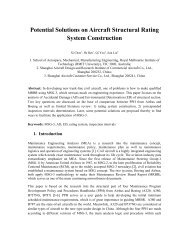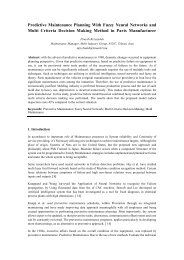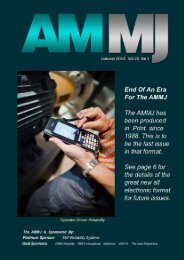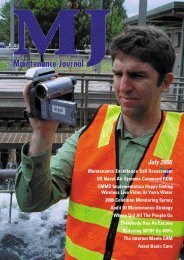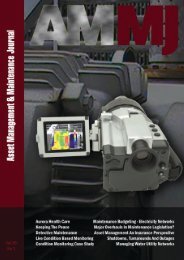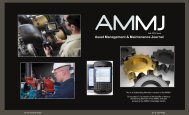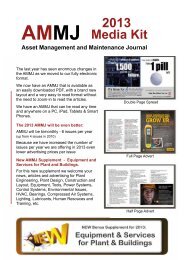July - AMMJ
July - AMMJ
July - AMMJ
You also want an ePaper? Increase the reach of your titles
YUMPU automatically turns print PDFs into web optimized ePapers that Google loves.
<strong>AMMJ</strong><br />
Maintenance Decision Support Project 36<br />
RESULTS<br />
The study did not identify any vibration variables that had strong association with the failures reported. In fact the<br />
results indicate that most failures were due to operational techniques, rather than to mechanical deterioration. This is<br />
considered a valuable finding of the study as it does indicate the area on which to focus asset management training<br />
as well as the CBM program itself. For the former, a lesson is to spend more time in training operators on correct<br />
pump operation. For the latter, we may examine the returned value of the VA program. It is recommended to track<br />
(through a living RCM process) VA’s good and bad calls in order to have an evaluation of the program’s predictive<br />
performance. Such an evaluation, consistent with continuous improvement, will result in more a more effective CBM<br />
program. The objectives of improvement are<br />
1) Discrimination of failure and suspension leading to more dependable decision models, and<br />
2) determination of vibration or other condition monitoring extracted features that reflect actually occurring<br />
failure modes.<br />
CONCLUSIONS<br />
This was a preliminary study based on a small sample of pumps operating over only a two year period. The authors<br />
intend to expand the sample and to apply the lessons learned relative to the management of failure and suspension<br />
data, particularly the following:<br />
1. Improve the management of the work order to RCM relationship by identifying both the failure mode and<br />
the Event type (either PF, FF, or S) on the work order.<br />
2. Report the failure mode as a reference to a FMEA record where it is defined in the context of the<br />
Function, Functional failure, and Effects.<br />
3. Include in the free text field of the work order both “what was found” as well as “what was done”.<br />
4. Update the FMEA dynamically, based on day-to-day observations surrounding the execution of a work<br />
order. The work order free text should, to the extent justified, support updates to the Effects text field of<br />
a FMEA/RCM record in a continuous process of knowledge refinement. The work order free text should<br />
be examined by the reliability engineer in order to expand the Effects text of the RCM knowledge base<br />
to cover all reasonably likely situations that may arise in the course of the enterprise’s operations.<br />
Feedback and exchange of these concepts with the technicians should occur regularly.<br />
5. Understand the requirements for an unbiased sample before attempting Reliability Analysis. The<br />
characteristics of a sample for reliability analysis are illustrated in Figure 5.<br />
6. Perform Reliability Analysis. This is, relatively speaking, the easiest part of the entire process as long as<br />
the considerations discussed thus far have been understood and respected by the reliability engineer<br />
and maintenance personnel involved in the work order process.<br />
ACKNOWLEDGEMENT<br />
This paper acknowledges the following people:<br />
For support and encouragement provided by co-authors M Wiseman and Dr D Lin (OMDEC),<br />
For assistance from C Hill (CMA) and S Mustadanagic (Iwaki)<br />
For suggestions from Dr. Naaman Gurvitz (Clockwork Solutions)<br />
REFERENCES<br />
[1] http://www.reliasoft.com/products.htm<br />
[2] http://www.plant-maintenance.com/<br />
[3] http://www.isograph-software.com/<br />
[4] Weibull, W. (1951), “A statistical distribution function of wide applicability”,<br />
J. Appl. Mech.-Trans.ASME 18 (3): 293–297 .<br />
[5] Jardine A.K.S., Banjevic D., Wiseman M.., Buck S. and Joseph T. “Optimising a Mine Haul Truck Wheel<br />
Motors’ Condition Monitoring Program: Use of Proportional Hazards Modelling”,<br />
http://www.omdec.com/moxie/About/cases/<br />
[6] Living RCM and EXAKT forums, http://www.omdec.com/wiki/tiki-forums.php<br />
[7] Mixed Populations Mathematical Basis, Naaman Gurvitz, Clockwork Solutions Inc.<br />
http://www.clockwork-solutions.com<br />
[8] http://www.omdec.com/wiki/tiki-index.php?page=The+elusive+PF+interval<br />
NOTES<br />
N1. “More conservative” in the sense that because CBM (assuming that the CBM detection confidence is high enough) detects “potential”<br />
failures, which, by definition, have few or minor consequences. Hence fewer functional failures, having severe consequences, will slip through.<br />
N2. A suspension is a renewal of a part or component (failure mode) for any reason other than failure. Without making the distinction between<br />
failure and suspension on the completed work order, no data based reliability analysis will be possible.<br />
N3 From the historical records of condition monitoring data, the past transitions from each state to all other states can be compiled in a matrix<br />
and the probabilities of each transition can be thus determined. These probabilities when combined with the Proportional Hazard Model will yield<br />
a failure prediction. For a detailed explanation and more information see Ref 8.<br />
N4 “Living” RCM (LRCM) is a dynamic process whereby work orders are linked to RCM/FMEA knowledge records, each link constituting a data<br />
point in a sample for reliability analysis. Secondly, the RCM/FMEA records should be updated as each work order reveals new knowledge about<br />
a failure and its effects. Ref 6.<br />
Vol 24 No 3




